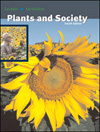|
 |  Plants and Society, 4/e Dr. Estelle Levetin,
University of Tulsa
Karen McMahon,
University of Tulsa
Feeding A Hungry World
Chapter Summary| 1. Approximately 20% of the world’s population receives insufficient food to meet daily nutritional requirements. The major challenge in agriculture is producing enough food to feed the world’s population. Dramatic improvements in crop yield have been achieved through breeding of high-yielding and disease-resistant varieties.
2. Since the 1970s, efforts have been made to increase the yields of major crops in developing nations. The central focus of the Green Revolution has been the use of high-yielding and disease-resistant varieties; however, these crops are high-impact crops. Yields depend on fertilizer and pesticide application, adequate water, and mechanized farming, making it economically impossible for poor farmers. Other problems include high energy cost, environmental damage, and loss of genetic diversity. Some scientists feel that the whole premise behind the Green Revolution needs to be reexamined. Increased food production is dangerous in areas where the population growth is unchecked, because it ultimately means more people will starve.
3. The loss of genetic diversity in crop plants and their wild ancestors because of monocultural practices is a serious concern to plant breeders. The cultivation of just one or two high-yielding varieties for most major crops has resulted in the loss of thousands of traditional varieties, and with them their genetic heritage. Monoculture is, in itself, an unstable system in that a single pest or disease can wipe out the crop of an entire region of essentially genetically identical and similarly susceptible individuals.
4. Sustainable agriculture is a movement away from the instability of current monocultural practices to a more environmentally sound approach in which crops are harvested without degradation to the environment. The monoculture of annuals would be replaced with a mixture of perennial crops more closely resembling a natural system.
5. Germplasm is the genetic information encoded within a plant; it is the raw material of the plant breeder, and without it, the creation of new varieties is impossible. Genetic erosion results when germplasm is lost to the plant breeder because traditional varieties are no longer cultivated or when wild ancestors become extinct because of habitat destruction. Seed banks preserve valuable germplasms by providing a storehouse for the seeds of domesticated plants and their wild relatives. An approach taken by other groups is to encourage the continued cultivation of traditional varieties. As the incalculable value of germplasm is realized, the question of ownership and a country's proprietary rights to this natural resource are being challenged and defined.
6. Although there are approximately 50,000 species of edible plants, only three domesticated crops provide over 50% of the calories from plants in the human diet. The search for locally used crops that have the potential to be developed for expansion on the world market is an ongoing one. Some alternative crops that might play a bigger role in feeding a hungry world are quinoa, amaranth, tarwi, tamarillo, naranjilla, and oca.
7. Biotechnology is being used along with traditional breeding to develop high-yielding and disease resistant cultivars. Methods of biotechnology, including cell culture and genetic engineering, can be used to introduce desired traits such as insect resistance into an established crop plant. Transgenic plants contain one or more genes transferred from another species and express that gene by producing a foreign protein.
8. The first genetically engineered plant was approved for commercial marketing in 1994, and by 2001, 60% to 70% of the processed foods in U.S. markets contained at least one ingredient from a genetically modified plant. Although there are many environmental and safety concerns about the use of GM crops, this technology has the potential to enhance food production in coming decades. |
|
|



 2006 McGraw-Hill Higher Education
2006 McGraw-Hill Higher Education

 2006 McGraw-Hill Higher Education
2006 McGraw-Hill Higher Education